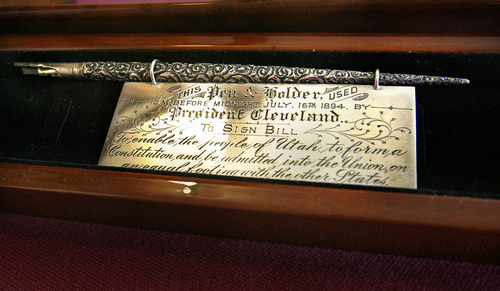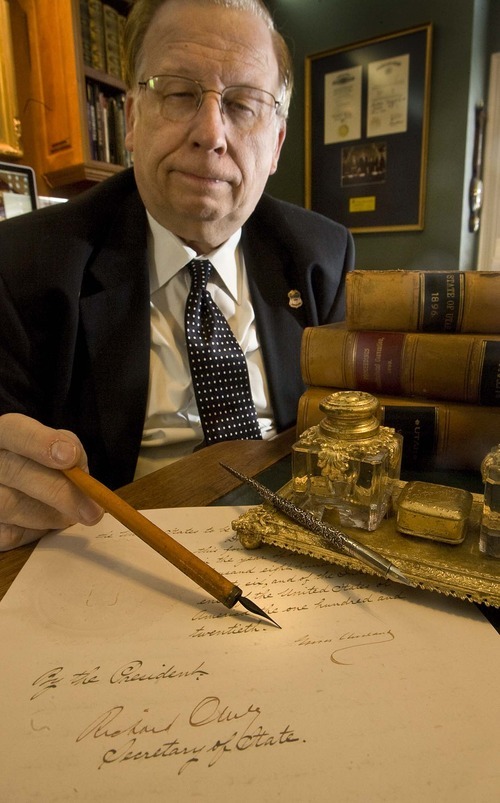This is an archived article that was published on sltrib.com in 2011, and information in the article may be outdated. It is provided only for personal research purposes and may not be reprinted.
This being Utah's 115th Statehood Day, you're probably wondering what happened to the pen that made it all happen.
That would be the so-called "Statehood Pen" that President Grover Cleveland used to sign the proclamation, which — after an exodus from the U.S., a near-revolt in 1857 and four decades of petitioning — made Utah the 45th American state.
And as any Utah eighth-grader knows, Cleveland's signature also decreed in Utah the complete separation of church and state and the abolition of polygamy.
The homely pen that accomplished so much history on Jan. 4, 1896, was instantly proclaimed a near-holy relic by the people of Utah.
An article in The Salt Lake Herald, printed on Jan. 4, 1896, makes the pen's place in history clear: "The People of Utah are naturally showing an intense interest in every step being made at Washington, and Secretary [Henry Thomas] Thurber has been importuned to ... preserve as a valuable historical relic the pen with which President Cleveland affixes his signature to the documents."
Yet any Utah history buff who rejoices in trekking to the Golden Spike monument, visiting This Is The Place State Park or whose heart stirs upon gazing into the abyss of the Kennecott Copper Mine, unfortunately can forget about a pilgrimage to see the Statehood Pen.
Simply put: The pen is lost.
One of the reasons might be that the "coveted" pen doesn't sound particularly unique, as described in a January 1896 Salt Lake Tribune article: "[Thurber] also brought with him the pen which had been used, a simple stub pen, inserted into a wooden holder, with which the president had signed this most important document. Secretary Thurber handed the pen over to Delegate [Frank] Cannon, in accordance with his promise made to him some time ago, and Mr. Cannon will carry it in person to Utah and deliver it to Gov. Wells for preservation in the historical archives of the new State. There were mutual felicitations in the delegation upon the event."
In fact, it was basically a Bic pen of its time. Sadly, those newspaper articles are probably the last mention of Statehood Pen. It has since become the Holy Grail for Utah history buffs, a mystery much as the Ark of the Covenant tantalized, then eluded Indiana Jones, says Utah historian Will Bagley.
Bagley figures the pen likely went to the Deseret Museum that once stood across the street from the Alta Club in downtown Salt Lake City. But when the museum closed in 1918, its collection was scattered to other museums, including that of the Daughters of the Utah Pioneers, State Historical Society and the intriguingly named Hall of Relics.
According to the Utah History Encyclopedia: "At that time the collections were divided up, with the taxidermied animals and some prehistoric items going to Brigham Young University, the geological specimens and some animals to the University of Utah, and the bulk of the pioneer historical material being retained by the [Church of Jesus Christ of Latter-day Saints]."
Other relics apparently got mislabeled, misplaced or just went missing. "It's sad but some things were lost," Bagley said. "There's a lot of artifacts out there missing."
History buff Ron Fox has made a personal quest of finding lost Utah relics, including the Statehood Pen. Other lost historical artifacts include the gavel for the constitutional convention and the gavel for the first Legislature. "I hate it when things get lost to history," Fox says.
His hunch is that delegate Cannon never passed on the "coveted" relic to the "historical archives of the new state" since it was never mentioned again.
Despite their enthusiasm at statehood, Utahns at the end of the 19th-century were still a hardscrabble lot. When early patriotic groups tried to gather relics for historical celebrations, they had little success. "There was never much," Fox said. "Utahns were still pioneers. Objects were utilitarian. They just used them and threw them away."
The pen really never mattered to Utah's statehood status, yet it's significant as physical evidence of history is important. "A pen the President of the United States used to put our state into being has relevance," Fox says. "It brings history alive."
He hasn't given up hope that the pen is collecting dust in some Utah family's attic, in a box perhaps with the lost commemorative umbrellas, canes and pocket watches presented to state's first Speaker of the House and Senate President.
Evidence of Utah history
For an idea of the statehood frenzy that occurred in Utah on Jan. 5, 1896, The Salt Lake Herald carried this over-heated headline series:
Let All Rejoice
This is the Day when Statehood Will Come
A Mighty Demonstration
It Will Be Spontaneous and Unanimous Throughout Utah
The Cannon Will Boom, Bells Will Ring and Banners Wave …
And the next day, just as predicted, The Herald reported:
The Queen of the West at last takes her place among the sisterhood of states.
Salt Lake goes wild.
Beyond the headlines, the paper reported: "Whistles sounded, cannons thundered, bells tolled, and the deafening sounds of hundreds of bombs formed but a part of the greatest jubilation witnessed in the intermountain region."
The pen that President Grover Cleveland used to sign Utah into the Union has become the Holy Grail of Utah history buffs.





